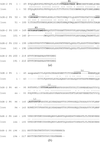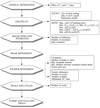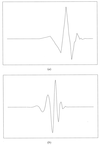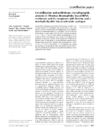issue contents
May 2000 issue

Cover illustration: C-terminal EF-hand of MRP8. Seven oxygen ligands interact with calcium forming a pentagonal bipyramidal coordination (p. 559).
research papers
Bovine heart cytochrome c oxidase has two azide-binding sites, one at the haem a3 iron and the other hydrogen bonded to the well conserved amino acids Asn422 and Tyr379 of subunit I on the transmembrane surface. Three histidine ligands are clearly observed at CuB in the azide-bound form.
PDB reference: cytochrome c oxidase, 1ocz
The structure of human aldose reductase is reported in space group P21. Inhibitor IDD384 is bound in a different conformation to that observed in the porcine enzyme.
The deuterium atoms of water molecules bound to concanavalin A are observed directly in neutron Laue density maps. These results afford a new level of detail, not attainable even by ultra-high resolution X-ray crystallography, in understanding saccharide binding and molecular recognition.
PDB reference: concanavalin A, 1c57
The structure of phosphate-free, native S. griseus aminopeptidase (SGAP) is reported at 1.58 Å resolution, along with the 1.53 Å resolution structure of its complex with a methionine product analogue. These studies enable the tracing of a previously disordered region of SGAP (Glu196–Arg202) and suggest that Glu131 is critically involved in the catalytic mechanism of the enzyme.
The structure of human MRP8 in the calcium-bound form has been investigated at 1.9 Å resolution. The N- and C- terminal EF-hands show clear differences in calcium binding and in its replacement.
PDB reference: MRP8, 1mr8
The three-dimensional crystal structure of S. marcescens endonuclease has been refined at 1.1 Å resolution to an R factor of 12.9% and an Rfree of 15.6% with the use of anisotropic temperature factors.
PDB reference: endonuclease, 1ql0
The monoclonal antibody hGR-2 F6 has been raised against the human glucagon receptor and shown to act as a competitive antagonist. As a first step in the structural characterization of the receptor, the crystal structure of the Fab fragment from this antibody is reported at 2.1 Å resolution.
PDB reference: Fab hGR-2 F6, 1dqd
The complex formed between the antistasin-type inhibitor bdellastasin and porcine β-trypsin has been crystallized in the tetragonal crystal form of space group P41212 and solved and refined to 2.7 Å resolution. A comparison with the porcine β-trypsin–bdellastasin complex of the enantiomorphic space group P43212 and other known crystal structures of porcine β-trypsin–macromolecular inhibitor complexes suggests that deamidation, isomerization and racemization of trypsin residue Asn115 is the key step in its crystallization.
PDB reference: β-trypsin–bdellastasin complex, 1eja
Parameters derived from the distribution of φ, ψ, χ1 angles (representing the main-chain and side-chain conformations) of different residues are found to be correlated with the β-sheet propensities, providing an insight into the formation of β-sheets.
The resolution limit of crystals of E. coli inorganic pyrophosphatase (PPase) was extended from 1.8 to 1.15 Å by flash-cooling recycling experiments.
The analyses of the data processing (DREAR) and SnB parameters have enabled a set of default values as well as a set of general guidelines to be proposed for determining Se-atom substructures.
It is shown that wavelet coefficients contain information which can be used to extend the resolution of electron-density maps.
Phase extension from 10 to ∼7 Å is achieved by adding new details to electron-density maps. New values for the coefficients in the wavelet transform are predicted in order to increase the resolution.
crystallization papers
Mouse L-chain apoferritin has been crystallized without metallic salts and should further allow the study of the interaction between L-chain ferritin and the iron core.
A truncated form of human tetranectin has been crystallized in two different crystal modifications to determine the oligomerization state of the protein. A molecular-replacement solution at 4.5 Å resolution shows the truncated form to be trimeric as in full-length tetranectin.
Two crystal forms of the streptogramin A acetyltransferase have been prepared and diffract to 2.5 and 2.7 Å.
The crystallization of a soluble form of the Rieske iron–sulfur protein II (soxF) from S. acidocaldarius is reported. A complete native data set has been collected to 1.64 Å resolution at 100 K.
Recombinant L4 ribosomal proteins from the thermophilic bacterium T. maritima and the halophilic archaeon H. marismortui have been crystallized and the crystals have been preliminarily characterized. The halophilic L4 variant could be treated under conventional salt conditions during purification and crystallization.
Pk-REC, a protein that binds to DNA and catalyzes the central step of recombination and repair, was crystallized in two forms in the space group  .
.
A new form of arylsulfatase A crystals has been obtained under acidic conditions. The crystal structure has been solved by molecular replacement.
Orthorhombic crystals of the copper enzyme nitrous oxide reductase from P. pantotrophus have been obtained and shown to diffract X-rays to 3 Å resolution using an in-house source.
The high-potential iron–sulfur protein from T. tepidum, which is an electron donor to the photosynthetic reaction centre, was crystallized and the structure was preliminarily solved by the molecular-replacement method.
Crystals of the membrane-bound E. coli dihydroorotate dehydrogenase have been obtained. X-ray diffraction experiments showed that they belong to one of the tetragonal space groups  or
or  , with the asymmetric unit containing between four and eight molecules of 37 kDa protein.
, with the asymmetric unit containing between four and eight molecules of 37 kDa protein.
The gene coding for saccharopine reductase from M. grisea was cloned and expressed in Escherichia coli. The enzyme was crystallized in space groups C2 and C2221, with cell dimensions a = 115.0, b = 56.6, c = 74.3 Å, β = 111.1° for space group C2 and a = 89.3, b = 119.0, c = 195.9 Å for space group C2221.
Cucurmosin, a ribosome-inactivating protein purified from pumpkin, the sarcocarp of C. moschata, has been crystallized using polyethylene glycol as a precipitant.
Crystals of T. thermophilus leucyl-tRNA synthetase and its complexes with leucine and a leucyl-adenylate analogue have been obtained. Crystals belonging to the space group C2221, with unit-cell parameters a = 102.4, b = 154.1, c = 174.3 Å, diffract to 1.9 Å.
Crystals of the enzyme N-acetylglucosamine 6-phosphate deacetylase from E. coli, involved in the catabolism of aminosugars, have been obtained and diffract to 2.0 Å resolution.


 journal menu
journal menu











































